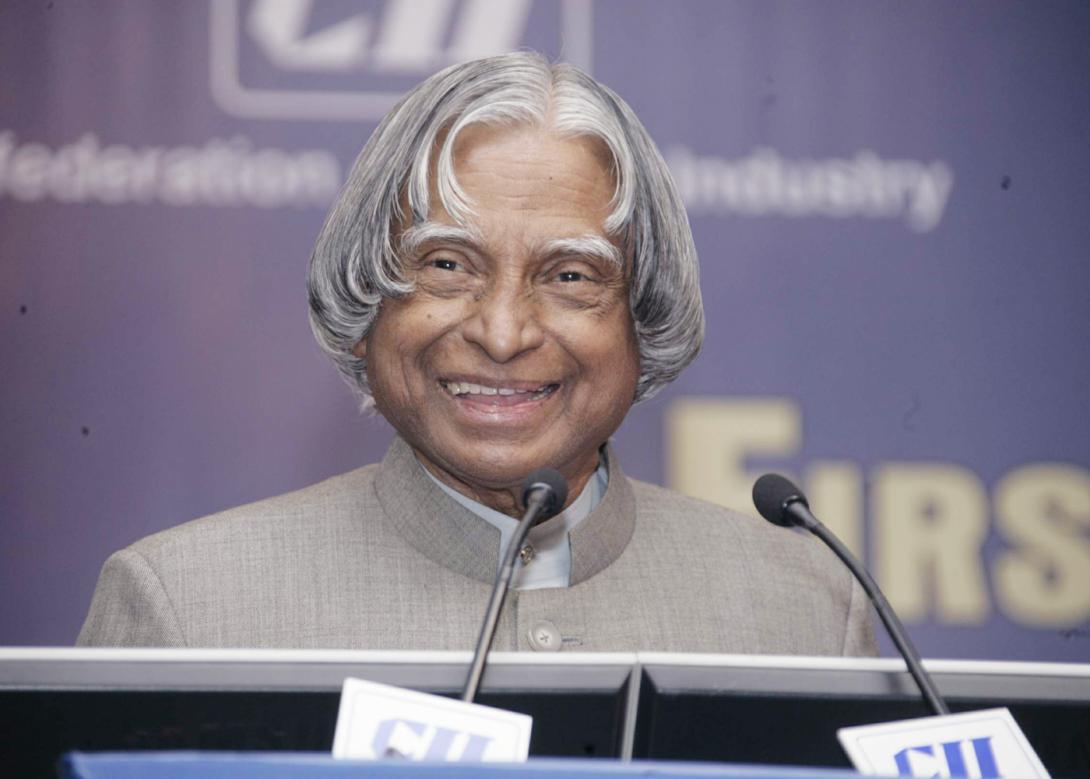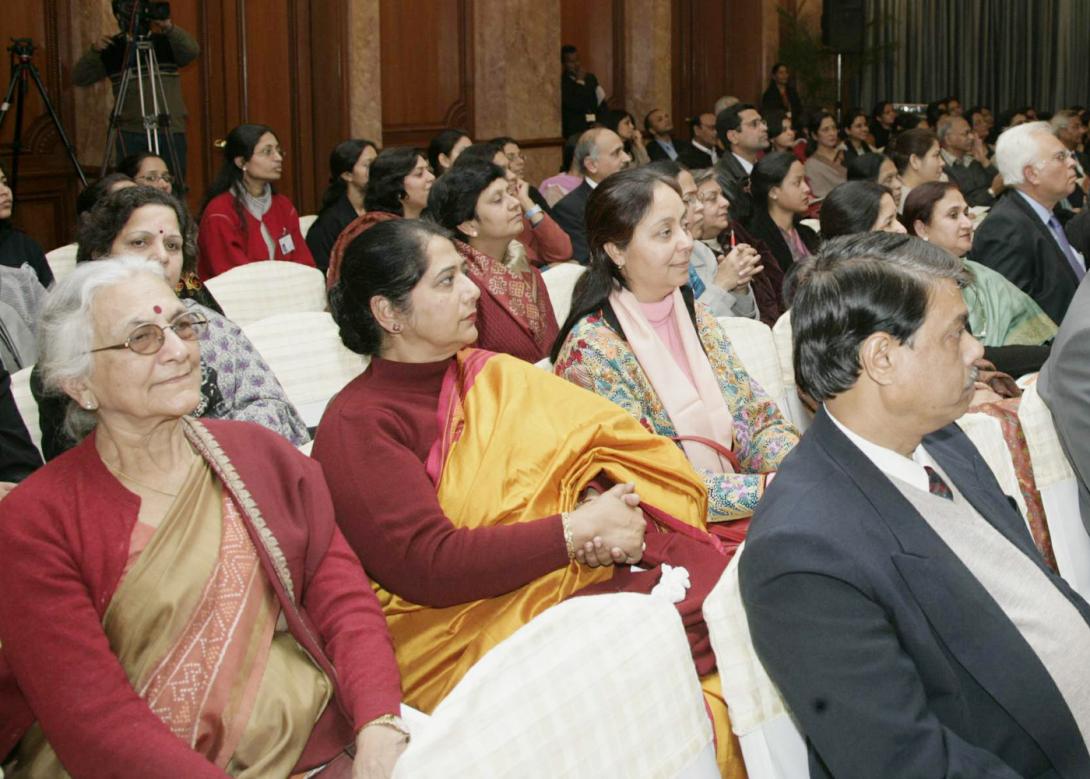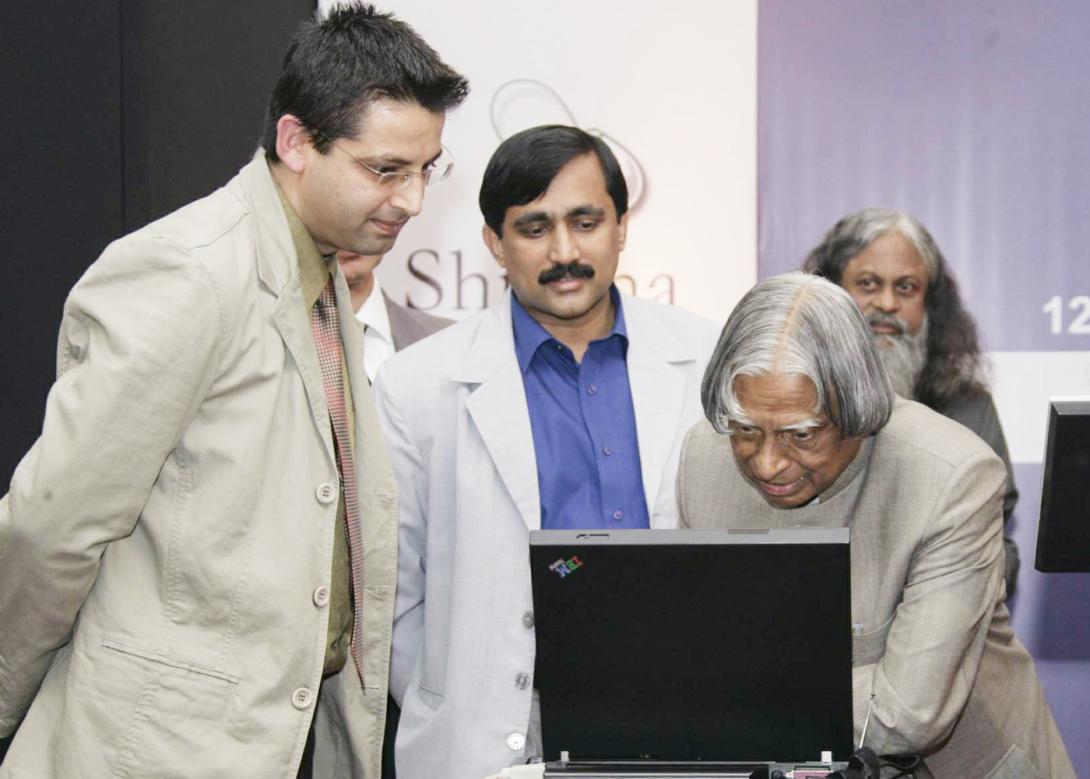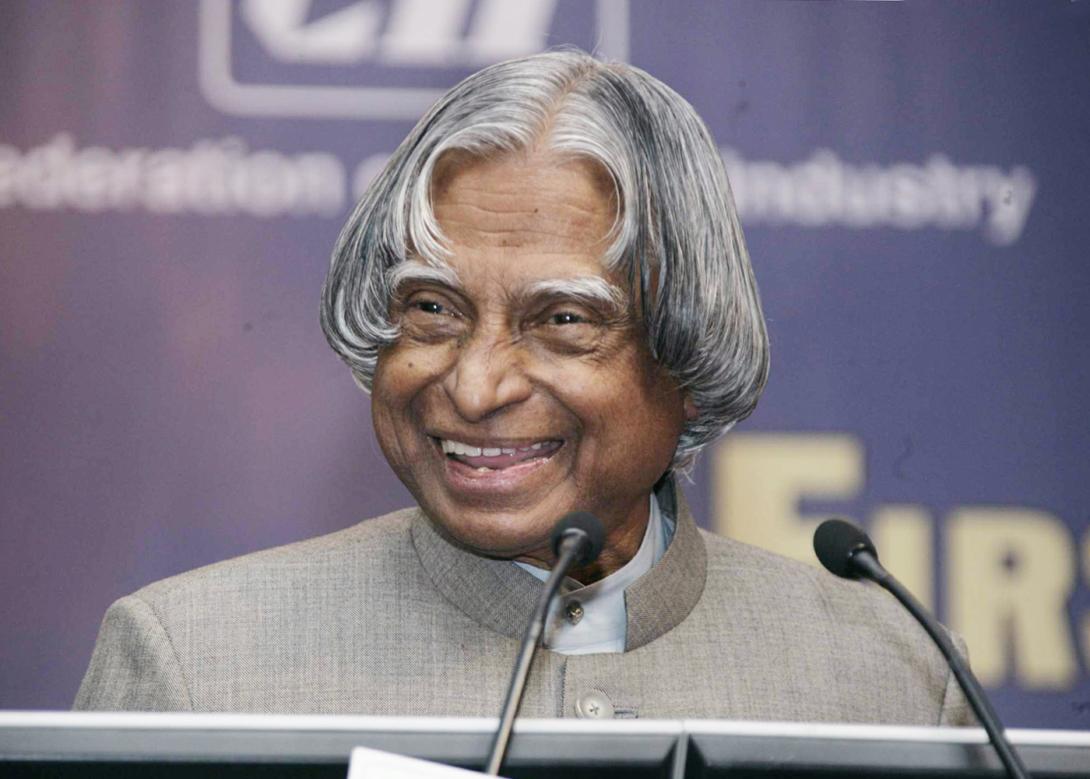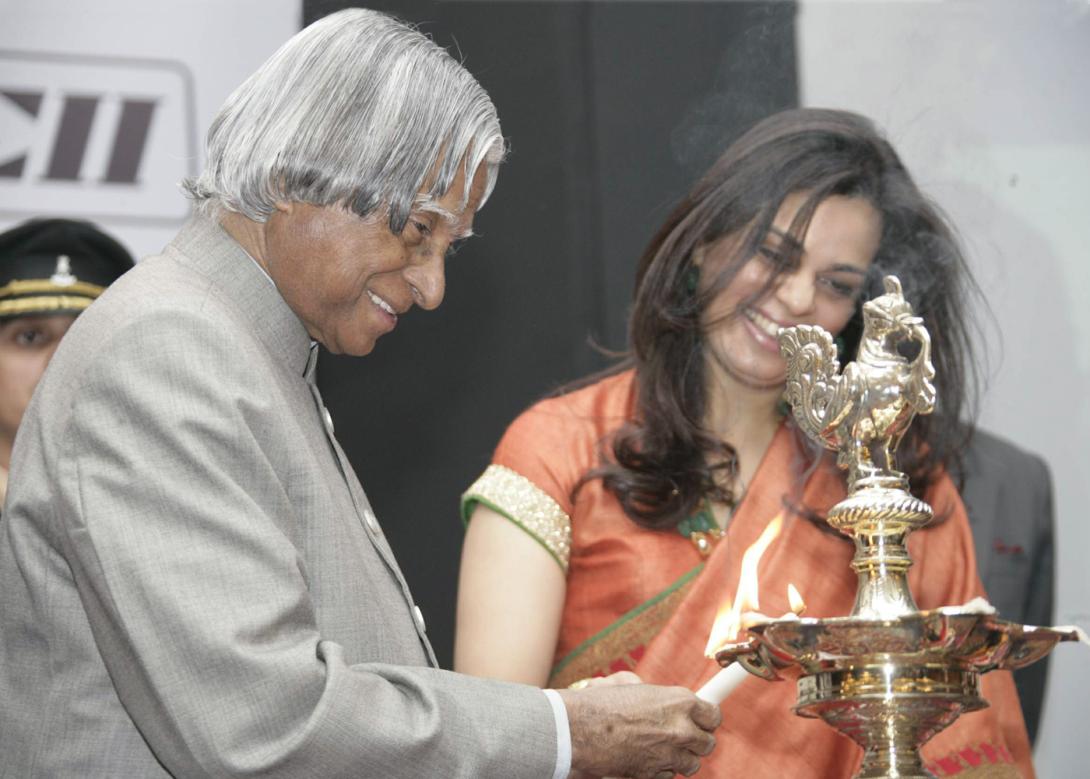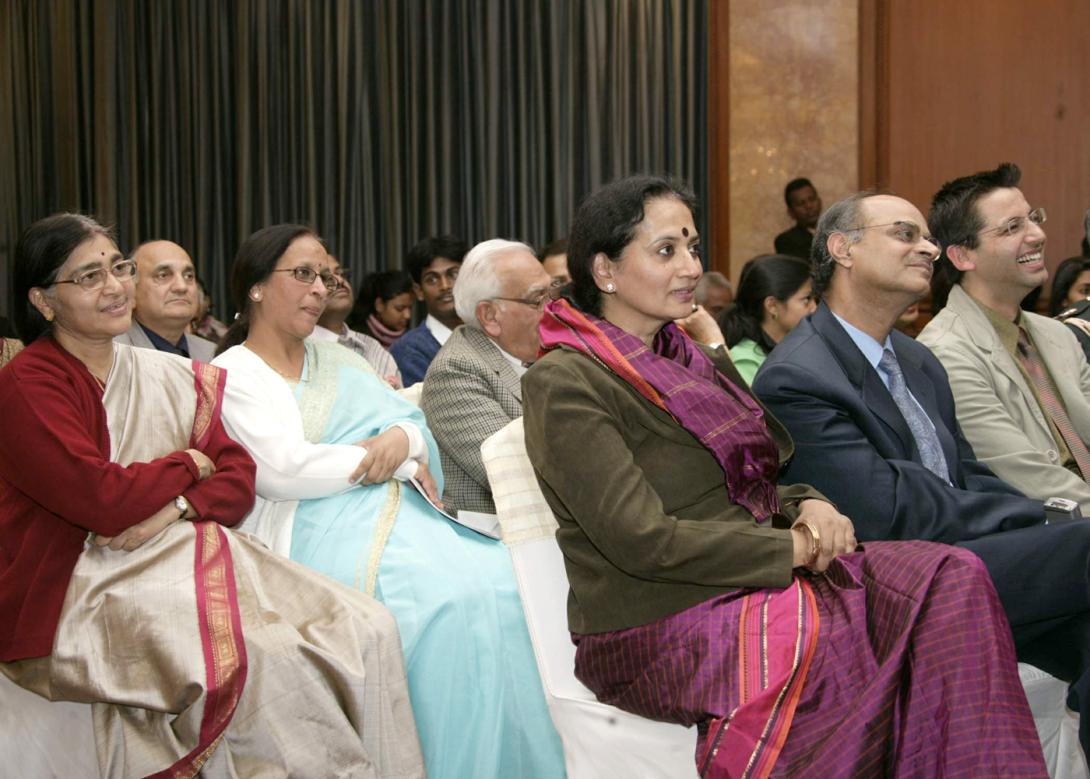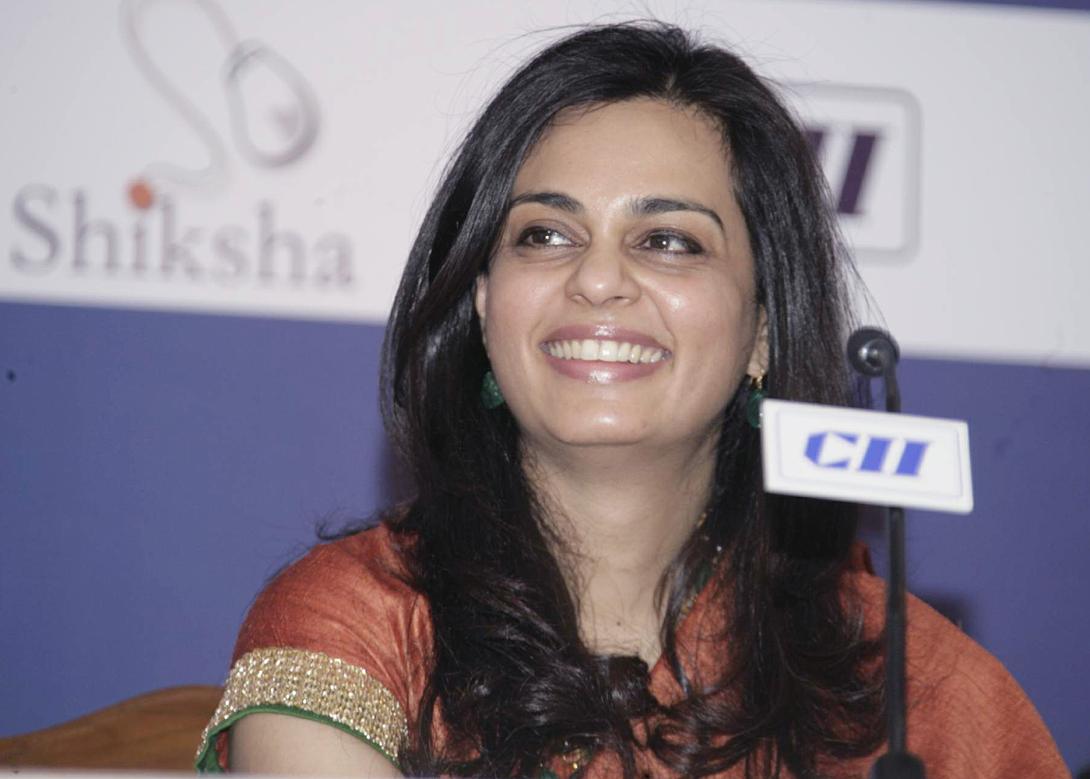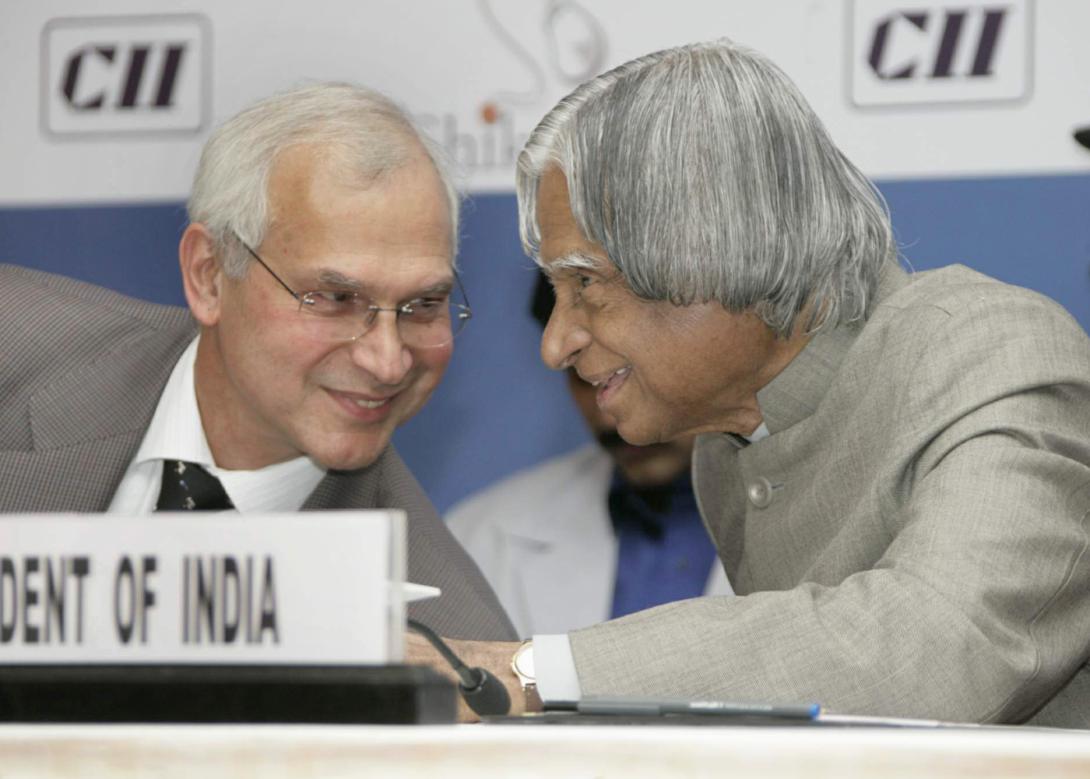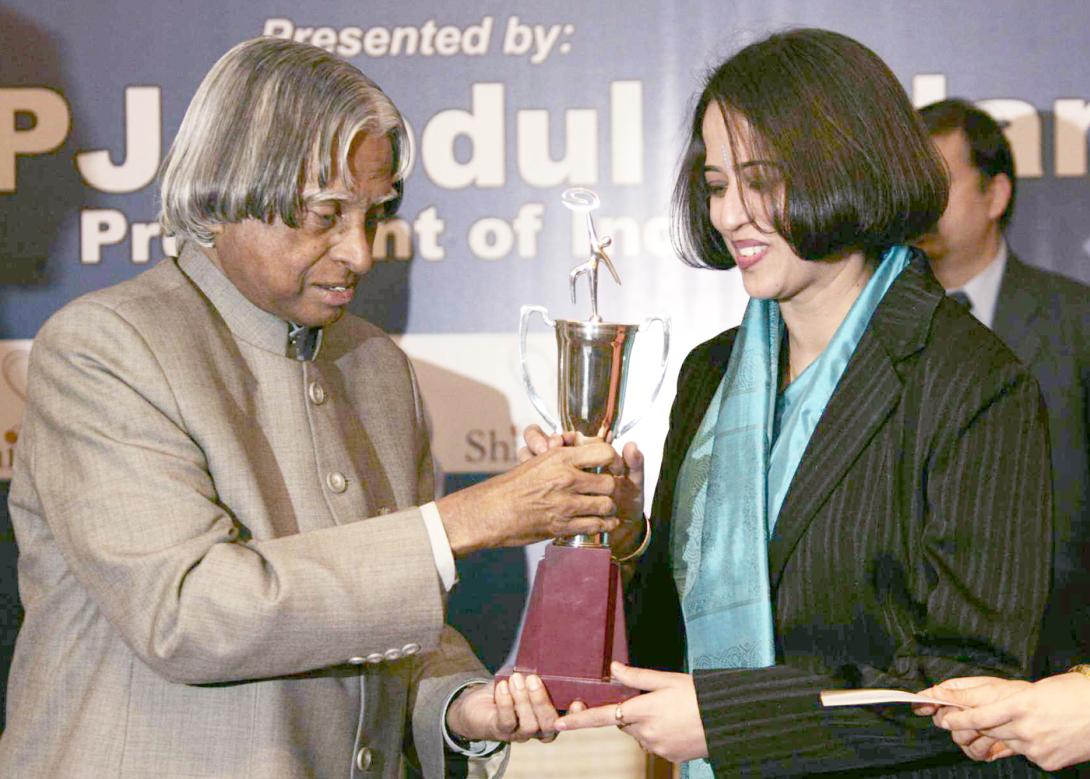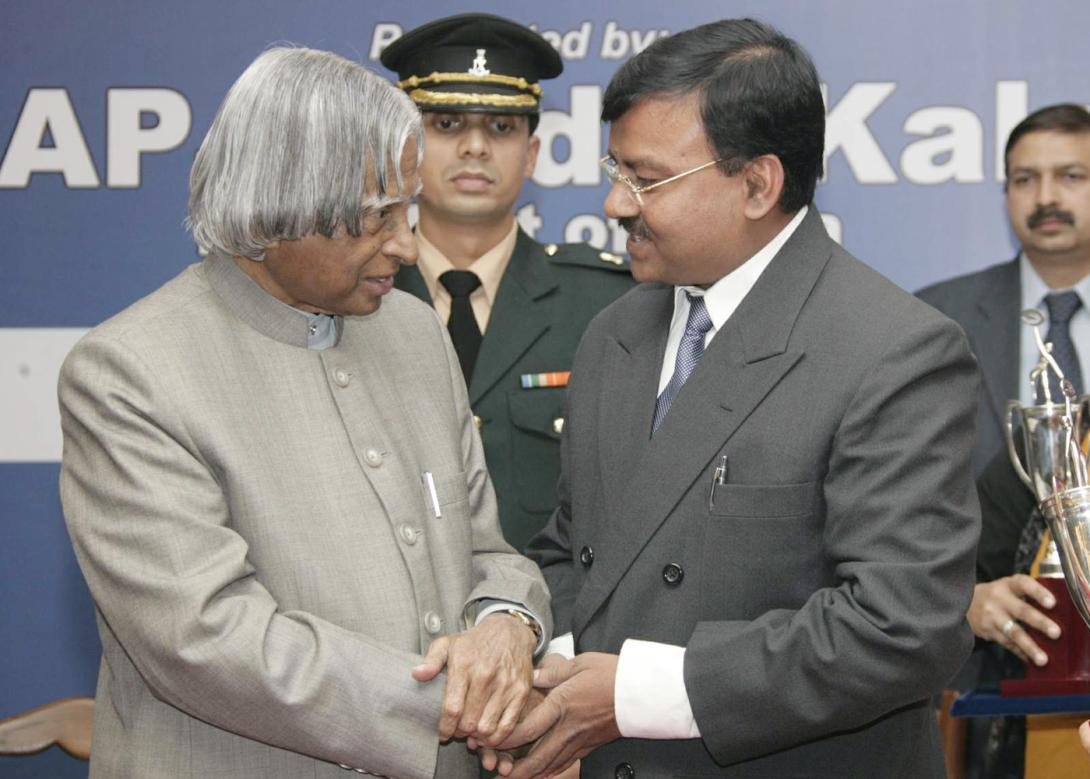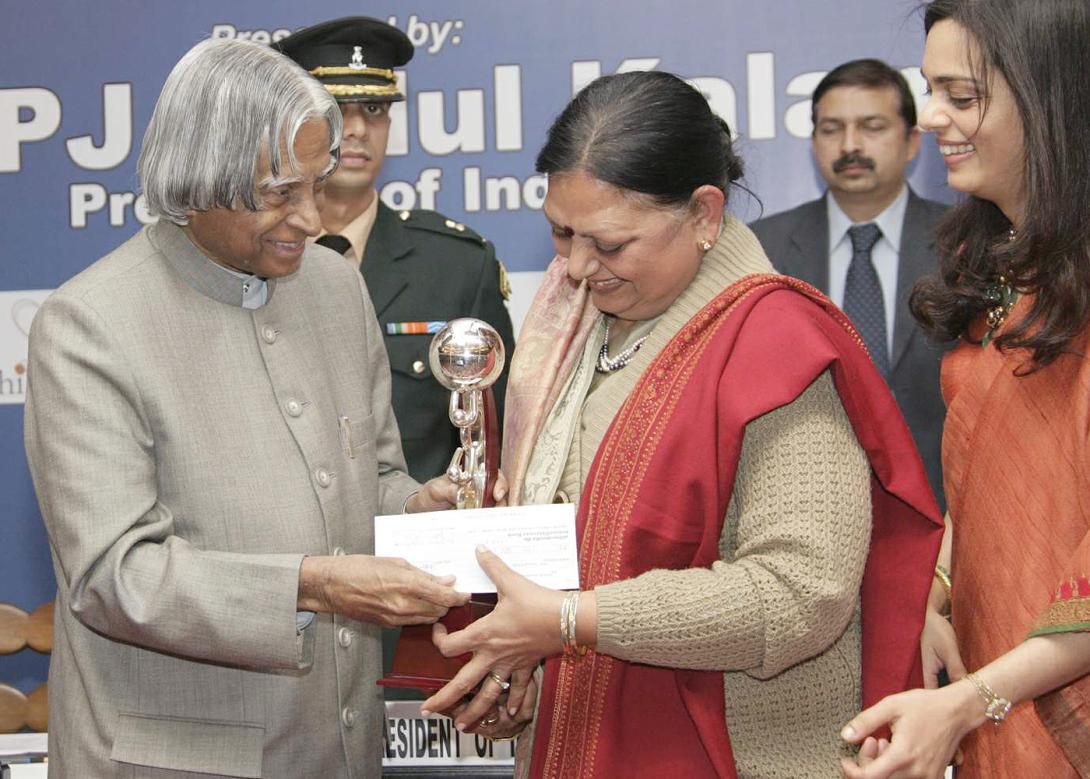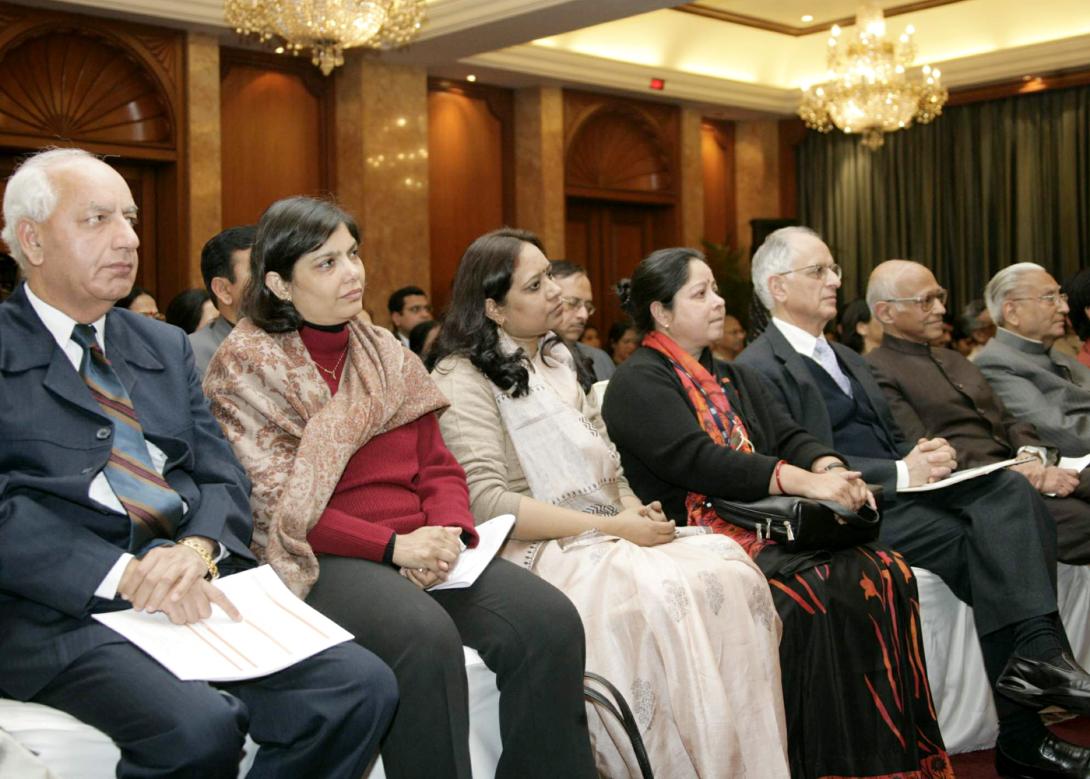Address at the Shiksha E-award Event, New Delhi
New Delhi : 12-01-2007
Knowledge makes you Great
Thinking provides knowledge
I am delighted to participate in the First Shiksha e-Awards event being organized by CII - Shiksha India Trust and also happy to inaugurate the E-learning Collaborative Portal. My greetings to the Shri Jamshyed N. Godrej, Chairman, Shiksha India Trust, Smt Sharmila Dalmia, Founder Executive of the Trust and other partners of the mission who have contributed to Shiksha mission and creation of the portal. I congratulate the Shiksha e-Award winners for promoting best educational practices using modern e-technology tools. Since today is the National Youth Day, it is appropriate to launch the Shiksha Portal today which will benefit the large number of youth.
Shiksha profile
The core competence of Shiksha portal is providing a platform for content development and delivery by the interested teachers, experts and the students. The content may cover physics, chemistry, maths, biology, geography in English, Hindi, Tamil and other languages. Presently Shiksha has designed the content for 32 modules of multimedia rich, school curriculum in CDs for children in the age group 12-16. I am happy that Skisha has reached 457 rural based NVS Schools and 100 other Non-NVS schools; it has also reached 300 schools in small/big towns and cities through Computer Based Tutorial CDs. To improve its efficiency and reachability, the organizers say that the portal being launched today will have all the contents available within a month.
Now I would like to share few thoughts on the topic "Dynamics of Education System". The profile of the education is continuously changing: in primary school, creativity is the focus, in the secondary school, preparing the students for selecting their future courses including science is the aim and in college and university education generating researchers and generating professional entrepreneurs is important.
Role of Education in Societal transformation
The whole purpose of education in a country like India is to develop and enhance the potential of our human resources and progressively transform it into a knowledge society. This can be done only through quality teachers and with quality content. Above all the teachers should love teaching. I am sure Shiksha develops these characteristics among the teachers. The knowledge society will be a society producing products and services that are rich in both explicit and tacit knowledge, thus creating value added products. The real capital of this knowledge society will be its knowledge workers. The society will be highly networked to create knowledge intensive environment along with enabling process to efficiently create, share, use and protect knowledge. Our education system should re-align itself at the earliest to meet the needs of the present day challenges and be fully geared to participate in the societal transformation. Shiksha is a step forward in this direction as it enhances the quality of learning. Knowledge Society enriches information society through innovation. Information society enriches agriculture and manufacturing through value addition. Thus societal transformation is enabled through knowledge society leading to economic growth.
Changing Pattern of Society
When the world was moving from the industrial to information and knowledge era, we witnessed a changing pattern in the sectoral share of GDP and the number of people employed in each sector. The sectoral share of Gross Domestic Product (GDP) percentage has undergone a considerable change. Contribution of agriculture to India?s GDP has reduced from 39% to 22% during the period 1979 to 2006. During the same period contribution of manufacturing sector has moved from 24% to 27% and whereas the contribution from the services sector has increased from 37% to 51%. There has been considerable change in the employment pattern also. The percentage of people employed in agriculture has come down from 64% to 52%. Simultaneously, the percentage of people employed in manufacturing has gone up from 15% to 20% and in the service sector from 20% to 28%. This trend has to continue and by 2020 our employment pattern should aim at 44% in agriculture, 21% in manufacturing and 35% in service sectors. Of course, manpower reduction in agriculture has to be met with increased technological input.
The displacement of 10% people from agriculture sector has to be facilitated through skill enabling for undertaking value added tasks in the rural enterprises so that migration to urban area is reduced. Instead of persons from the rural areas going to urban towns in search of jobs in manufacturing and services sectors, PURA (Providing Urban Amenities in Rural Areas) facilitates creation of employment in the rural areas itself. PURA achieves this by providing physical, electronic and knowledge connectivities to a cluster of villages thereby leading to their economic connectivity and prosperity. Shiksha should become a major partner in providing knowledge connectivity to the rural clusters. Knowledge creation and knowledge utilization is the key to the success of a PURA programme.
Characteristics of the Knowledge economy
I was studying different dimensions of knowledge society and how will it be different from the industrial Economy. In the knowledge economy the objective of a society changes from fulfilling the basic needs of all round development to empowerment. The education system instead of going by text book teaching will be promoted by creative, interactive self learning ? formal and informal with focus on values, merit and quality. I am sure; Shiksha will be able to provide this type of support to the students. The workers instead of being skilled or semi-skilled will be knowledgeable, self empowered and flexibly skilled. The type of work instead of being structured and hardware driven will be less structured and software driven. Management style will be delegative rather than being directive. Impact on environment and ecology will be strikingly less compared to industrial economy. Finally, the economy will be knowledge driven.
Global Human Resources Cadre
Presently our university education system is contributing 3 million graduates and post graduates every year and the students seeking employment after completion of 10th class and 10+2 class are around 7 million per year. Thus nearly 10 million youth are injected into the employment market every year. In the 21st century, India needs large number of talented youth with higher education for the task of knowledge acquisition, knowledge imparting, knowledge creation and knowledge sharing. There is a large gap in the availability of employable skill. How to bridge this gap is the question. To bridge the gap, an interface is needed between the school curriculum and the needs of the three sectors of the economy. At present India has five hundred and forty million youth under the age of 25 which will continuously be growing till the year 2050. Keeping this resource in mind, the Universities and educational systems should create two cadres of personnel: (1) a global cadre of skilled youth with specific knowledge of special skills (2) another global cadre of youth with higher education. These two cadres will be required not only for powering the manufacturing and services sector of India but also will be needed for fulfilling the human resource requirements of various countries. Thus, the universities and secondary school education system will have to work towards increasing the through put of the higher education system from the existing 11% to 20% by the year 2015, 30% by the year 2020 and 50% by the year 2040. The other Indians who are not covered by the higher education system should all have world class skill sets in areas such as construction, carpentry, electrical systems, repair of mechanical systems, fashion design, para-legal, para-medical, accountancy, sales and marketing, software and hardware maintenance and service, software quality assurance personals etc. No Indian youth should be without either a world class higher education or without world class skills sets. This is the mission which must be undertaken by all our Universities and the educational systems. Shiksha programme should think of extending the system for providing world class vocational skills to our youth for making them internationally competitive, so that this will bridge the employable skill gap. We have to start right now to realize this goal since the overall time available for such an educational growth is short. Global Human Resources Cadre.
Presently our university education system is contributing 3 million graduates and post graduates every year and the students seeking employment after completion of 10th class and 10+2 class are around 7 million per year. Thus nearly 10 million youth are injected into the employment market every year. In the 21st century, India needs large number of talented youth with higher education for the task of knowledge acquisition, knowledge imparting, knowledge creation and knowledge sharing. There is a large gap in the availability of employable skill. How to bridge this gap is the question. To bridge the gap, an interface is needed between the school curriculum and the needs of the three sectors of the economy. At present India has five hundred and forty million youth under the age of 25 which will continuously be growing till the year 2050. Keeping this resource in mind, the Universities and educational systems should create two cadres of personnel: (1) a global cadre of skilled youth with specific knowledge of special skills (2) another global cadre of youth with higher education. These two cadres will be required not only for powering the manufacturing and services sector of India but also will be needed for fulfilling the human resource requirements of various countries. Thus, the universities and secondary school education system will have to work towards increasing the through put of the higher education system from the existing 11% to 20% by the year 2015, 30% by the year 2020 and 50% by the year 2040. The other Indians who are not covered by the higher education system should all have world class skill sets in areas such as construction, carpentry, electrical systems, repair of mechanical systems, fashion design, para-legal, para-medical, accountancy, sales and marketing, software and hardware maintenance and service, software quality assurance personals etc. No Indian youth should be without either a world class higher education or without world class skills sets. This is the mission which must be undertaken by all our Universities and the educational systems. Shiksha programme should think of extending the system for providing world class vocational skills to our youth for making them internationally competitive, so that this will bridge the employable skill gap. We have to start right now to realize this goal since the overall time available for such an educational growth is short.
Conclusion
The portal is indeed a unique contribution towards the accelerated learning process for the youth of the nation. This to succeed, the citizens should get higher bandwidth access and acquire the capability of using Internet in rural areas. Availability of bandwidth will enable free movement of molecules and atoms instead of men and material on the road. Net also creates an excellent framework for collaborative computing and collaborative development. Hence every one in the community can develop knowledge for others to consume. We become both creators and consumers of knowledge. This way it will have a sustainable and exponential growth. I would suggest all experts in the fields and teachers of India and abroad to create contents, learning modules and share their pearls of wisdom with our youth. What we are starting today by CII is an impressive engine with great potential to change the country and change the way education is imparted to our youth, particularly in rural areas. Since number of such e-learning initiatives is coming up, I would suggest the inclusion of e-learning as a subject in the B.Ed syllabus, so that adequate capacity can be built among the educators for maximizing the benefits from such e-learning programmes to the students.
I wish the members of Shiksha team success in their mission of serving five hundred and forty million Indian youth by meeting their just-in-time educational needs in a personalized manner.
May God bless you.
Eleven Point Oath for Teachers
1. First and foremost, I will love teaching. Teaching will be my soul.
2. I will achieve proficiency in e-learning systems and encourage students to make use of the available e-learning system in the country.
3. I realize that I am responsible for shaping not just students but ignited youth who are the most powerful resource under the earth, on the earth and above the earth. I will be fully committed to the great mission of teaching.
4. I will consider myself to be a great teacher only when I am capable of elevating the average student to the high performance.
5. I will organize and conduct my life, in such a way that my life itself is a message for my students.
6. I will encourage my students and children to ask questions and develop the spirit of enquiry, so that they blossom into creative enlightened citizens.
7. I will treat all the students equally and will not support any differentiation on account of religion, community or language.
8. I will continuously build the capacities in teaching so that I can impart quality education to my students.
9. I realize by being a teacher, I am making an important contribution to the efforts of national development.
10. I will constantly endeavour to fill my mind, with great thoughts and spread the nobility in thinking and action among my students.
11. I will always celebrate the success of my students.
I am delighted to participate in the First Shiksha e-Awards event being organized by CII - Shiksha India Trust and also happy to inaugurate the E-learning Collaborative Portal. My greetings to the Shri Jamshyed N. Godrej, Chairman, Shiksha India Trust, Smt Sharmila Dalmia, Founder Executive of the Trust and other partners of the mission who have contributed to Shiksha mission and creation of the portal. I congratulate the Shiksha e-Award winners for promoting best educational practices using modern e-technology tools. Since today is the National Youth Day, it is appropriate to launch the Shiksha Portal today which will benefit the large number of youth.
Shiksha profile
The core competence of Shiksha portal is providing a platform for content development and delivery by the interested teachers, experts and the students. The content may cover physics, chemistry, maths, biology, geography in English, Hindi, Tamil and other languages. Presently Shiksha has designed the content for 32 modules of multimedia rich, school curriculum in CDs for children in the age group 12-16. I am happy that Skisha has reached 457 rural based NVS Schools and 100 other Non-NVS schools; it has also reached 300 schools in small/big towns and cities through Computer Based Tutorial CDs. To improve its efficiency and reachability, the organizers say that the portal being launched today will have all the contents available within a month.
Now I would like to share few thoughts on the topic "Dynamics of Education System". The profile of the education is continuously changing: in primary school, creativity is the focus, in the secondary school, preparing the students for selecting their future courses including science is the aim and in college and university education generating researchers and generating professional entrepreneurs is important.
Role of Education in Societal transformation
The whole purpose of education in a country like India is to develop and enhance the potential of our human resources and progressively transform it into a knowledge society. This can be done only through quality teachers and with quality content. Above all the teachers should love teaching. I am sure Shiksha develops these characteristics among the teachers. The knowledge society will be a society producing products and services that are rich in both explicit and tacit knowledge, thus creating value added products. The real capital of this knowledge society will be its knowledge workers. The society will be highly networked to create knowledge intensive environment along with enabling process to efficiently create, share, use and protect knowledge. Our education system should re-align itself at the earliest to meet the needs of the present day challenges and be fully geared to participate in the societal transformation. Shiksha is a step forward in this direction as it enhances the quality of learning. Knowledge Society enriches information society through innovation. Information society enriches agriculture and manufacturing through value addition. Thus societal transformation is enabled through knowledge society leading to economic growth.
Changing Pattern of Society
When the world was moving from the industrial to information and knowledge era, we witnessed a changing pattern in the sectoral share of GDP and the number of people employed in each sector. The sectoral share of Gross Domestic Product (GDP) percentage has undergone a considerable change. Contribution of agriculture to India?s GDP has reduced from 39% to 22% during the period 1979 to 2006. During the same period contribution of manufacturing sector has moved from 24% to 27% and whereas the contribution from the services sector has increased from 37% to 51%. There has been considerable change in the employment pattern also. The percentage of people employed in agriculture has come down from 64% to 52%. Simultaneously, the percentage of people employed in manufacturing has gone up from 15% to 20% and in the service sector from 20% to 28%. This trend has to continue and by 2020 our employment pattern should aim at 44% in agriculture, 21% in manufacturing and 35% in service sectors. Of course, manpower reduction in agriculture has to be met with increased technological input.
The displacement of 10% people from agriculture sector has to be facilitated through skill enabling for undertaking value added tasks in the rural enterprises so that migration to urban area is reduced. Instead of persons from the rural areas going to urban towns in search of jobs in manufacturing and services sectors, PURA (Providing Urban Amenities in Rural Areas) facilitates creation of employment in the rural areas itself. PURA achieves this by providing physical, electronic and knowledge connectivities to a cluster of villages thereby leading to their economic connectivity and prosperity. Shiksha should become a major partner in providing knowledge connectivity to the rural clusters. Knowledge creation and knowledge utilization is the key to the success of a PURA programme.
Characteristics of the Knowledge economy
I was studying different dimensions of knowledge society and how will it be different from the industrial Economy. In the knowledge economy the objective of a society changes from fulfilling the basic needs of all round development to empowerment. The education system instead of going by text book teaching will be promoted by creative, interactive self learning ? formal and informal with focus on values, merit and quality. I am sure; Shiksha will be able to provide this type of support to the students. The workers instead of being skilled or semi-skilled will be knowledgeable, self empowered and flexibly skilled. The type of work instead of being structured and hardware driven will be less structured and software driven. Management style will be delegative rather than being directive. Impact on environment and ecology will be strikingly less compared to industrial economy. Finally, the economy will be knowledge driven.
Global Human Resources Cadre
Presently our university education system is contributing 3 million graduates and post graduates every year and the students seeking employment after completion of 10th class and 10+2 class are around 7 million per year. Thus nearly 10 million youth are injected into the employment market every year. In the 21st century, India needs large number of talented youth with higher education for the task of knowledge acquisition, knowledge imparting, knowledge creation and knowledge sharing. There is a large gap in the availability of employable skill. How to bridge this gap is the question. To bridge the gap, an interface is needed between the school curriculum and the needs of the three sectors of the economy. At present India has five hundred and forty million youth under the age of 25 which will continuously be growing till the year 2050. Keeping this resource in mind, the Universities and educational systems should create two cadres of personnel: (1) a global cadre of skilled youth with specific knowledge of special skills (2) another global cadre of youth with higher education. These two cadres will be required not only for powering the manufacturing and services sector of India but also will be needed for fulfilling the human resource requirements of various countries. Thus, the universities and secondary school education system will have to work towards increasing the through put of the higher education system from the existing 11% to 20% by the year 2015, 30% by the year 2020 and 50% by the year 2040. The other Indians who are not covered by the higher education system should all have world class skill sets in areas such as construction, carpentry, electrical systems, repair of mechanical systems, fashion design, para-legal, para-medical, accountancy, sales and marketing, software and hardware maintenance and service, software quality assurance personals etc. No Indian youth should be without either a world class higher education or without world class skills sets. This is the mission which must be undertaken by all our Universities and the educational systems. Shiksha programme should think of extending the system for providing world class vocational skills to our youth for making them internationally competitive, so that this will bridge the employable skill gap. We have to start right now to realize this goal since the overall time available for such an educational growth is short. Global Human Resources Cadre.
Presently our university education system is contributing 3 million graduates and post graduates every year and the students seeking employment after completion of 10th class and 10+2 class are around 7 million per year. Thus nearly 10 million youth are injected into the employment market every year. In the 21st century, India needs large number of talented youth with higher education for the task of knowledge acquisition, knowledge imparting, knowledge creation and knowledge sharing. There is a large gap in the availability of employable skill. How to bridge this gap is the question. To bridge the gap, an interface is needed between the school curriculum and the needs of the three sectors of the economy. At present India has five hundred and forty million youth under the age of 25 which will continuously be growing till the year 2050. Keeping this resource in mind, the Universities and educational systems should create two cadres of personnel: (1) a global cadre of skilled youth with specific knowledge of special skills (2) another global cadre of youth with higher education. These two cadres will be required not only for powering the manufacturing and services sector of India but also will be needed for fulfilling the human resource requirements of various countries. Thus, the universities and secondary school education system will have to work towards increasing the through put of the higher education system from the existing 11% to 20% by the year 2015, 30% by the year 2020 and 50% by the year 2040. The other Indians who are not covered by the higher education system should all have world class skill sets in areas such as construction, carpentry, electrical systems, repair of mechanical systems, fashion design, para-legal, para-medical, accountancy, sales and marketing, software and hardware maintenance and service, software quality assurance personals etc. No Indian youth should be without either a world class higher education or without world class skills sets. This is the mission which must be undertaken by all our Universities and the educational systems. Shiksha programme should think of extending the system for providing world class vocational skills to our youth for making them internationally competitive, so that this will bridge the employable skill gap. We have to start right now to realize this goal since the overall time available for such an educational growth is short.
Conclusion
The portal is indeed a unique contribution towards the accelerated learning process for the youth of the nation. This to succeed, the citizens should get higher bandwidth access and acquire the capability of using Internet in rural areas. Availability of bandwidth will enable free movement of molecules and atoms instead of men and material on the road. Net also creates an excellent framework for collaborative computing and collaborative development. Hence every one in the community can develop knowledge for others to consume. We become both creators and consumers of knowledge. This way it will have a sustainable and exponential growth. I would suggest all experts in the fields and teachers of India and abroad to create contents, learning modules and share their pearls of wisdom with our youth. What we are starting today by CII is an impressive engine with great potential to change the country and change the way education is imparted to our youth, particularly in rural areas. Since number of such e-learning initiatives is coming up, I would suggest the inclusion of e-learning as a subject in the B.Ed syllabus, so that adequate capacity can be built among the educators for maximizing the benefits from such e-learning programmes to the students.
I wish the members of Shiksha team success in their mission of serving five hundred and forty million Indian youth by meeting their just-in-time educational needs in a personalized manner.
May God bless you.
Eleven Point Oath for Teachers
1. First and foremost, I will love teaching. Teaching will be my soul.
2. I will achieve proficiency in e-learning systems and encourage students to make use of the available e-learning system in the country.
3. I realize that I am responsible for shaping not just students but ignited youth who are the most powerful resource under the earth, on the earth and above the earth. I will be fully committed to the great mission of teaching.
4. I will consider myself to be a great teacher only when I am capable of elevating the average student to the high performance.
5. I will organize and conduct my life, in such a way that my life itself is a message for my students.
6. I will encourage my students and children to ask questions and develop the spirit of enquiry, so that they blossom into creative enlightened citizens.
7. I will treat all the students equally and will not support any differentiation on account of religion, community or language.
8. I will continuously build the capacities in teaching so that I can impart quality education to my students.
9. I realize by being a teacher, I am making an important contribution to the efforts of national development.
10. I will constantly endeavour to fill my mind, with great thoughts and spread the nobility in thinking and action among my students.
11. I will always celebrate the success of my students.

